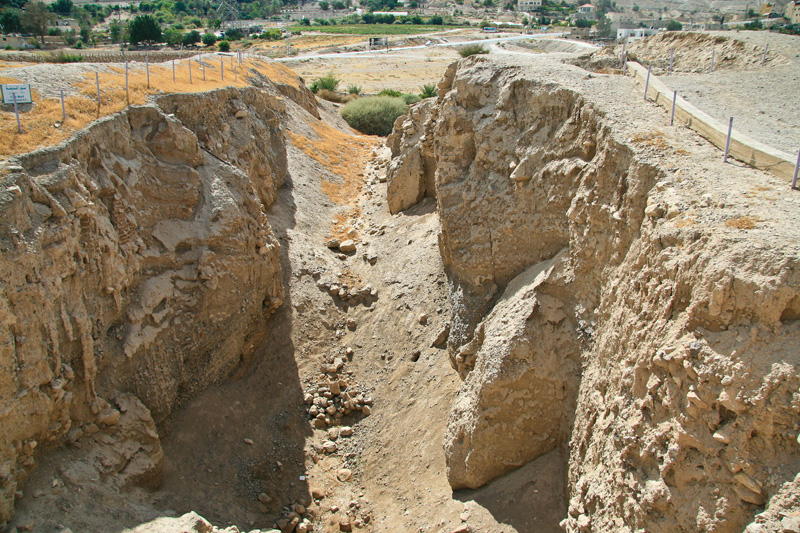I hiked up a dusty path leading to the ancient city of Jericho and stepped to the edge of a famous archeological wonder: Kathleen Kenyon’s trench. It is like a massive cake-slice into the ruins of the oldest city in the world. As a student the text-book images teased my imagination, there hunched under the buzzing fluorescent lights of my college library. But here, under the baking desert sun, I stood in awe looking down at the real thing. Layers of civilization, destruction, and time, were laid bare by Kenyon’s big dig down into this ancient mound. I was travelling with a professor who knew the place well, and she leaned over and asked if I wanted to go down and up close to the oldest building in the world. I knew what she was talking about. There, half revealed in the depths of the trench, stands the famous, “Tower of Jericho.” This massive stone edifice, which once loomed three storeys tall over the Jordan valley plains by the Dead Sea, was found intact under layers of history. By their estimates, this remarkable find is likely the oldest structure ever found, built thousands of years before Stonehenge, the advent of pottery, writing, and the wheel; around 8000 BC.
While perhaps not allowed today, my professor climbed down with me to the top of this tower, swung back the gate covering a hole, and stood with me peering into the dark. I eased down the steep 10,000 year old staircase, and into the cool depths of this stunning masterpiece. There I sat, quiet at the bottom, eyes adjusting, and touching the stone handiwork of the world’s first city-builders. Archeologists think it would have taken 11,000 working days to make such a structure, an early sign of civilization and cooperation, and one of the great leaps forward by our ancestors. But as I emerged from the tower I wondered if those builders could have imagined that their building would still be here ten thousand years later. Could I even imagine such a feat?
Twitter @1000yearhouse
There is a builder in Carlton Landing, Oklahoma, Clay Chapman, who has been exploring ways of building homes that last. He is building what he calls the “1000 Year House.” Using bricks, special mortar, and timeless techniques, his homes are intended to be passed down through the generations, not demolished after a few decades. It is a different way of understanding the cities we build. Instead of homes that may not last 75 years, Chapman believes in a longer vision for how we create neighbourhoods and communities. He says, “Architecture plays the singular role of an active, archival touchstone, tangibly connecting us to the past. Nothing unites us with our ancestors so practically.” His homes, he hopes, will still be here long after he is gone, telling a story for centuries. The oldest house in France, for example, is the 700 year old Maison de Jeanne. Countless barefoot children have been raised in this one home that sits like a time capsule for our futurist imaginations. It is conceivable that homes today, if built well, could be here for even longer. While we might be able to create houses that last, are we truly able to appreciate that grandeur of a such a vision?
My great-great grandfather Pouteaux’s home in Alderney
We are in an age of fast fashion, fast food, and fast achievement. Our architecture and community building often follows these disposable trends. Author Colin Ellard explores the psychogeography of our places and points to the city of Celebration, Florida, a community built by Disney. The city is built to look like it has age and heritage, but Ellard writes that it “conveys a Stepford-like perfection that negates feelings of authenticity.” Behind the façade of homes with no actual history there is a very real hope to enjoy something that is truly old and timeless. But history cannot be conjured or imposed, it can only be nurtured in the very real scope of time. There is no fast or quick way to give history to our neighbourhoods, we must take the pilgrimage ourselves. In the face of the fast, there is an emerging movement towards a life that is slower, and nurtured. Slow food invites us to gather around tables again, and gardeners are teaching us to grow more of what we eat. As a beekeeper I have begun to learn the pace of growing things; from pollination, to flower, to fruit. At this pace we are discovering that there is more to our city than just a collection of disconnected homes, but that our place is on its way to becoming something else. Whether that something else is life or decay, is perhaps in our hands to find out. Good things may be found and enjoyed where we live, but it requires time. The way we build our homes, our friendships, our gardens, our businesses, our places of worship and education do not have to reflect the disposable trends advertised to us. We can make something that lasts, and grows.
Community builders can offer a perspective of their neighbourhoods that may begin to seed a long-term imagination. Deep-time is the concept of looking back, far back, into the pre-history of the world. It can be humbling to consider the age of our world and cosmos, even a ten thousand year old tower causes us a moment to pause and wonder. Holding onto deep-time in one hand can help us point forward with the other. We can begin, albeit with a hazy vision, to look ahead and give ourselves the space to conceptualize and even curate a conversation around what it might take to prepare our city and community for the future. While we cannot predict what will be, we can create an environment where a 100 year, 500 year, or 1000 year neighbourhood is not absurd, but hoped for.
We can build our city and our neighbourhoods with this imagination. It is an imagination growing in one of the most challenged communities in North America. in 2019 I was invited to walk through the neighbourhood of Englewood, regarded as Chicago’s murder capital. Jonathan Brooks, a pastor in that community, explained that because of the high crime and few opportunities, many young people are encouraged by their families to leave the neighbourhood as soon as they can. The goal is to get out, and get away. This trend, he says, does not give people a reason to care. If children are taught that their community is worthless, and leaving it is the goal, then why not rob it, trash it, and step over anyone you come across on your way out the door? Brooks discovered that the solution lies in giving his community a new imagination for the future, to believe that this neighbourhood could be their home. In doing so, people are learning to care, invest, and build a city that could last.
I wonder if my neighbours wake up every morning to a disposable and rootless community. Do they see our neighbourhood of Rainbow Falls as a place to use and leave, or do they have an imagination for a place that was made to last, and community made to bless everyone who calls it home? I wonder, will others touch the city we built, read our stories, and comb over the evidence to discover that we cooperated, gathered, rooted, and established ourselves together, and for the benefit of others?
R. Lee Sharpe’s poem, A Bag of Tools, captures this sense of purpose, and call, to create neighbourhoods that last. It is an invitation to each of us as we nurture the culture of our neighbourhoods, stone by stone:
Isn’t it strange how princes and kings,
and clowns that caper in sawdust rings,
and common people, like you and me,
are builders for eternity?
Each is given a list of rules;
a shapeless mass; a bag of tools.
And each must fashion, ere life is flown,
A stumbling block, or a Stepping-Stone.







